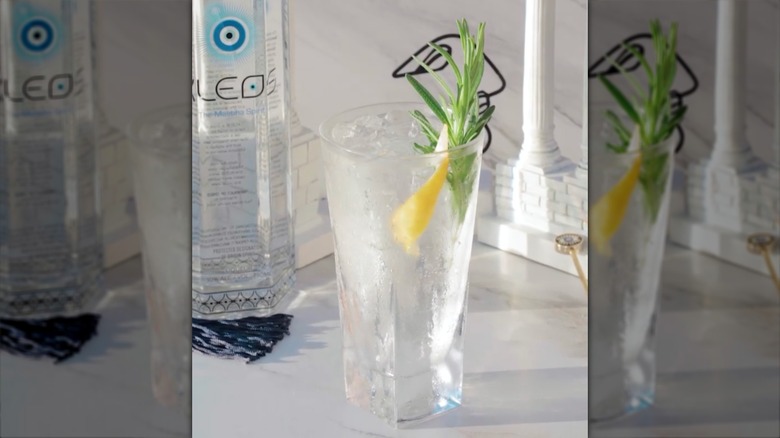Jose Andres' Gin And Tonic-Inspired Cocktail Features An Uncommon Ingredient
Born and raised in Spain, José Andrés, known for his role in the founding of the World Central Kitchen, knows a thing or two about mixing a good cocktail. In his latest cookbook, "Zaytinya: Delicious Mediterranean Dishes From Greece, Turkey, and Lebanon," he delves into all the classic Mediterranean recipes he grew up with, foods and drinks alike. In one of the pages, he spoke of his fondness for the "gintonic" (as Spaniards like to call the gin and tonic) — and how this love affair eventually led him to uncover a rare and exponentially more flavorful variation of the classic drink: the Mastiha and Tonic.
Even if you're a hardcore cocktail enthusiast, you might not have heard of mastiha before, considering how hard it is to come by outside of the Mediterranean. Also known as "mastika liqueur," this Greek liqueur imparts an herbal, woody flavor to whatever drink you add it to due to having plant resin added to it. Combined with the slightly bitter quinine of the tonic water, the result is a cocktail that's a bouquet of different herbal, grassy notes that make for a pretty unique tasting experience.
What is mastiha liqueur?
For this, we'll have to look to the peninsular country of Greece and the island of Chios to the far north of the Aegean Sea. Here, there's an entire industry devoted to harvesting the aromatic sap of the mastic tree. This sap can be mixed with alcohol and sugar to give you a sweet-tasting drink commonly used in Greece as both an aperitif and a digestif. Effie Panagopoulos, founder of Kleos Mastiha Spirit, told Observer that when consumed before a meal, it "removes all the gas" from your stomach and allows you to eat more. Mastiha can also be used as a digestion aid after a meal to help you feel less bloated, which is good to know for your upcoming mastiha and tonic.
A second type of mastiha is made by distilling the sap alongside alcohol. The result is a drier mastiha with a more pronounced herbal flavor and, according to Andrés, extra notes of "mint, lavender, and chamomile." Dry mastiha usually has a higher alcohol content, too, which makes it excellent for mixing drinks. That's why Andrés prefers to use the dry variant in his Mastiha and Tonic rather than sweet.
A mastiha and tonic is a drink that'll haunt you forever
In his book, Andrés commented that if you're a fan of a gin and tonic like him, having a taste of mastiha and tonic will "haunt you forever." Mastiha is remarkably similar to the botanicals found in gin. High-quality mastiha delivers a complex, layered flavor profile, too, so for the cocktail enjoyers out there who like their drink with plenty of nuances, this recipe will be a hit.
And just as London Dry gin like Tanqueray and Bombay is preferred for a classic gin and tonic, using dry mastiha is key for this cocktail. The more pronounced flavor of the mastic tree sap, combined with lower sweetness, ensures the tonic water's bitterness shines through, preventing an overly one-dimensional taste that sweet mastiha might create.
So, throw together dry mastiha, tonic water, and a dash of citrus juice to brighten up the flavor a little bit. See for yourself if your palate is forever changed by the drink or else!


